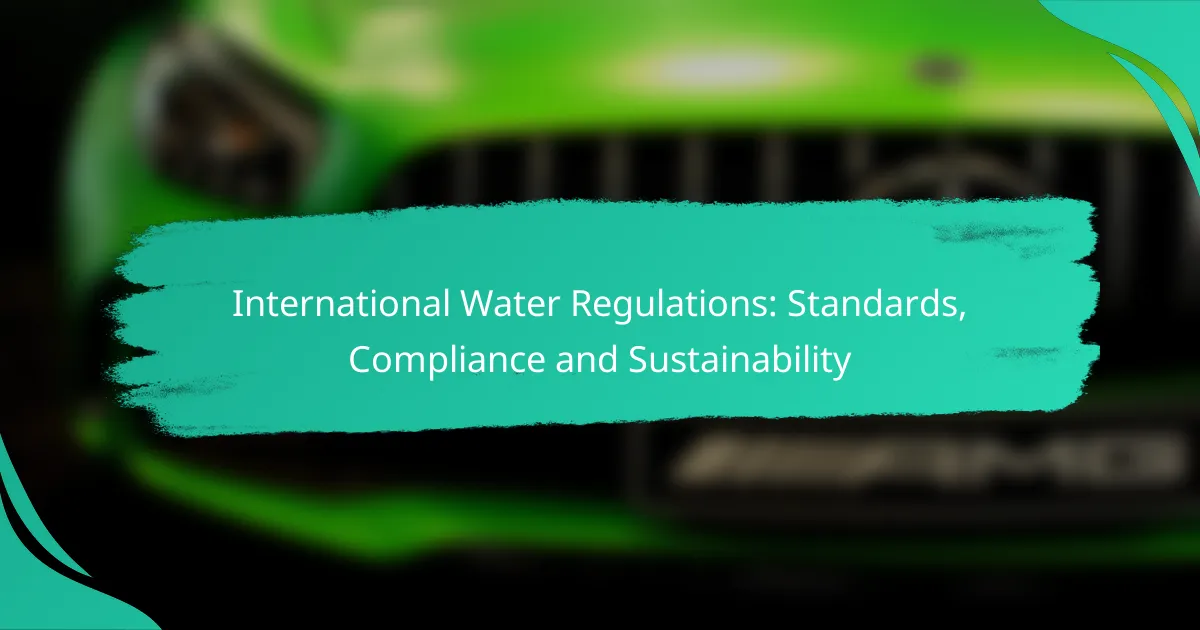International water regulations play a crucial role in establishing standards for water quality and management, fostering cooperation among nations to protect vital water resources. By ensuring compliance through national laws and monitoring systems, these frameworks aim to promote sustainable use and safe drinking water for all populations. Best practices in water sustainability emphasize efficient management and conservation, ensuring the long-term availability and quality of this essential resource.
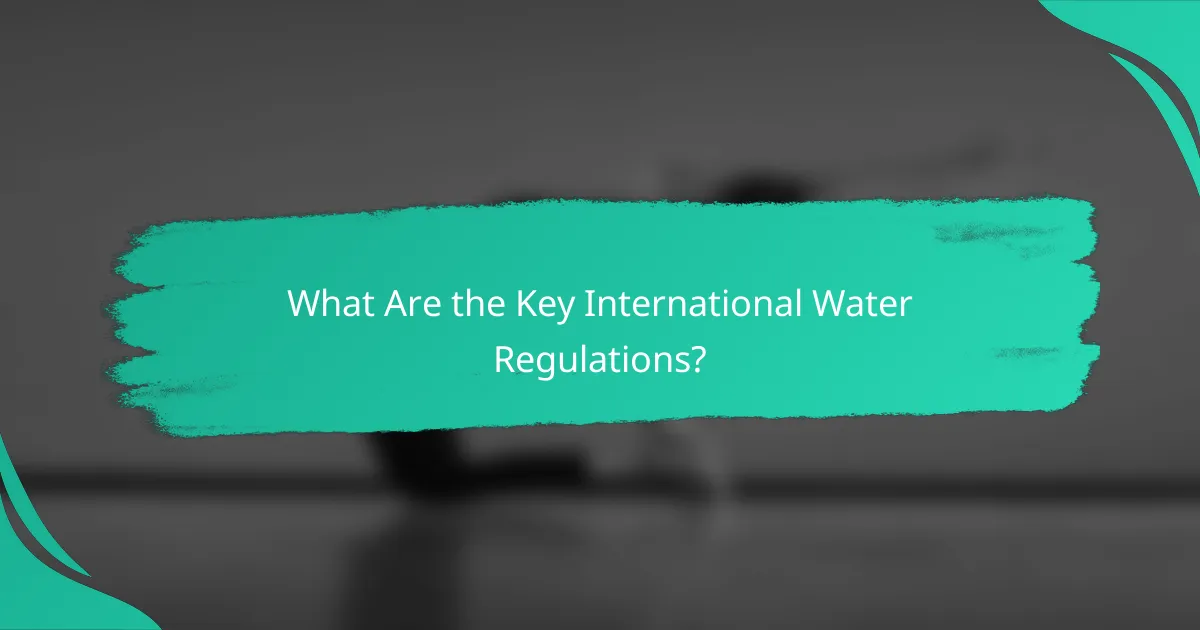
What Are the Key International Water Regulations?
Key international water regulations establish standards for water quality, management, and sustainability across borders. These frameworks aim to protect water resources, promote cooperation among nations, and ensure safe drinking water for all populations.
United Nations Watercourses Convention
The United Nations Watercourses Convention provides a framework for the management and protection of international watercourses. Adopted in 1997, it emphasizes the equitable and reasonable use of shared water resources, encouraging countries to cooperate in their management.
Countries that ratify this convention commit to preventing significant harm to other states and ensuring sustainable water use. For example, nations sharing a river basin must collaborate on pollution control and resource allocation to meet both ecological and human needs.
EU Water Framework Directive
The EU Water Framework Directive (WFD) aims to protect and enhance the quality of water across Europe. Enacted in 2000, it requires member states to achieve good ecological and chemical status for all water bodies by specific deadlines.
Key aspects include setting up river basin management plans, monitoring water quality, and implementing measures to reduce pollution. For instance, countries must assess the status of their waters and take action to address any identified issues, such as agricultural runoff or industrial discharges.
WHO Drinking Water Quality Guidelines
The World Health Organization (WHO) Drinking Water Quality Guidelines provide essential standards for safe drinking water. These guidelines outline acceptable levels of contaminants and pathogens to protect public health.
Countries are encouraged to adopt these guidelines to ensure that drinking water is free from harmful substances. For example, the guidelines specify limits for microbial contaminants, such as E. coli, and chemical pollutants, like lead, to safeguard consumer health and well-being.

How Do Countries Ensure Compliance with Water Regulations?
Countries ensure compliance with water regulations through a combination of national laws, monitoring systems, and reporting mechanisms. These frameworks are designed to protect water quality and promote sustainable use, often adapting to local environmental conditions and international standards.
National Regulatory Frameworks
National regulatory frameworks establish the legal basis for water management and protection. These frameworks typically include laws that define water quality standards, allocation rights, and penalties for non-compliance. For example, the European Union has directives that member states must follow, such as the Water Framework Directive, which sets specific goals for water quality.
Each country tailors its regulations to address local water issues, such as pollution from agriculture or industry. This means that while some countries may focus on strict limits for contaminants, others might prioritize sustainable water use practices, reflecting their unique environmental challenges.
Monitoring and Reporting Mechanisms
Monitoring and reporting mechanisms are essential for ensuring compliance with water regulations. Countries often implement regular testing of water bodies to assess quality and identify pollution sources. This can involve both government agencies and independent organizations conducting assessments to ensure transparency and accountability.
Additionally, many countries require industries and municipalities to submit regular reports detailing their water usage and compliance with established standards. These reports help regulators track progress and identify areas needing improvement. Effective monitoring can also involve public access to water quality data, fostering community engagement and awareness.
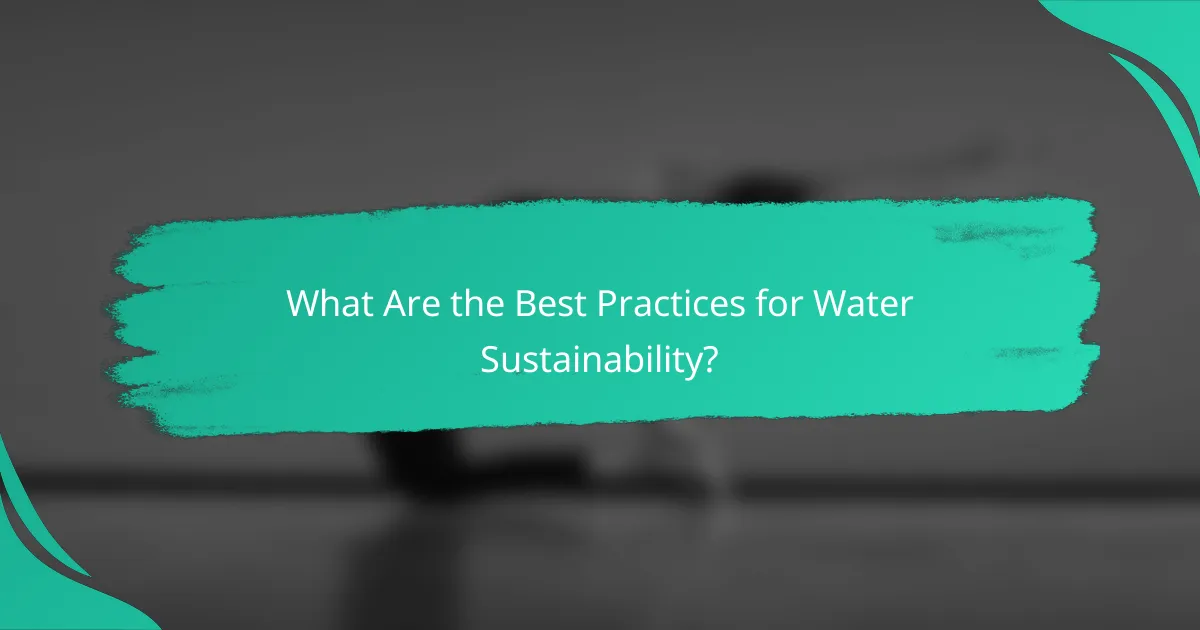
What Are the Best Practices for Water Sustainability?
Best practices for water sustainability focus on efficient management and conservation of water resources to ensure long-term availability and quality. Implementing these practices helps reduce waste, protect ecosystems, and promote responsible usage across various sectors.
Integrated Water Resource Management
Integrated Water Resource Management (IWRM) is a holistic approach that coordinates the development and management of water, land, and related resources. It aims to maximize economic and social welfare while minimizing environmental impacts. Key considerations include stakeholder involvement, data sharing, and balancing competing demands.
Effective IWRM involves assessing local water needs and resources, engaging communities, and establishing clear governance structures. For example, in regions facing water scarcity, prioritizing agricultural efficiency and urban water recycling can significantly enhance sustainability.
Water-Efficient Technologies
Water-efficient technologies are innovations designed to reduce water consumption and improve usage efficiency across various applications. These technologies can range from low-flow fixtures in households to advanced irrigation systems in agriculture. Implementing such technologies can lead to substantial water savings and lower utility costs.
Examples include drip irrigation, which delivers water directly to plant roots, and rainwater harvesting systems that collect and store rain for later use. Adopting these technologies not only conserves water but also supports compliance with local regulations aimed at promoting sustainability.

How Do Digital Products Facilitate Water Regulation Compliance?
Digital products streamline water regulation compliance by automating data collection, enhancing monitoring capabilities, and improving reporting accuracy. These tools enable organizations to efficiently meet regulatory standards and promote sustainable water management practices.
Data Management Software
Data management software plays a crucial role in organizing and analyzing water quality data. By centralizing information, these systems allow for real-time tracking of compliance metrics, making it easier to identify trends and potential issues.
When selecting data management solutions, consider features such as user-friendly interfaces, integration capabilities with existing systems, and compliance reporting tools. Popular options include cloud-based platforms that offer scalability and accessibility from various devices.
Remote Monitoring Solutions
Remote monitoring solutions enable continuous observation of water quality and usage without the need for on-site personnel. These systems utilize sensors and IoT technology to collect data on parameters like pH, turbidity, and flow rates, transmitting information to centralized dashboards.
Implementing remote monitoring can significantly reduce operational costs and enhance response times to potential violations. Ensure that the chosen solution complies with local regulations and offers robust data security measures to protect sensitive information.

What Are the Challenges in Implementing Water Regulations?
Implementing water regulations faces several challenges, including inadequate funding and political obstacles. These issues can hinder compliance with international standards and affect sustainability efforts.
Funding and Resource Allocation
Securing adequate funding for water regulation initiatives is a significant challenge. Many countries struggle with limited budgets, which can lead to insufficient resources for monitoring and enforcement activities. For example, developing nations often allocate only a small percentage of their GDP to water management, impacting their ability to meet international standards.
Effective resource allocation is crucial for successful implementation. Governments and organizations should prioritize investments in infrastructure, technology, and training to enhance compliance. Collaborating with international donors can also provide additional financial support and expertise.
Political and Legal Barriers
Political and legal barriers can significantly impede the implementation of water regulations. Conflicting interests among stakeholders, such as industries and environmental groups, can lead to delays and compromises that weaken regulatory frameworks. In some cases, political instability may divert attention and resources away from water management efforts.
Legal challenges can arise when existing laws are outdated or poorly enforced. Countries must ensure that their legal frameworks align with international water standards and are adaptable to changing environmental conditions. Engaging in dialogue with all stakeholders and fostering transparency can help mitigate these political and legal obstacles.
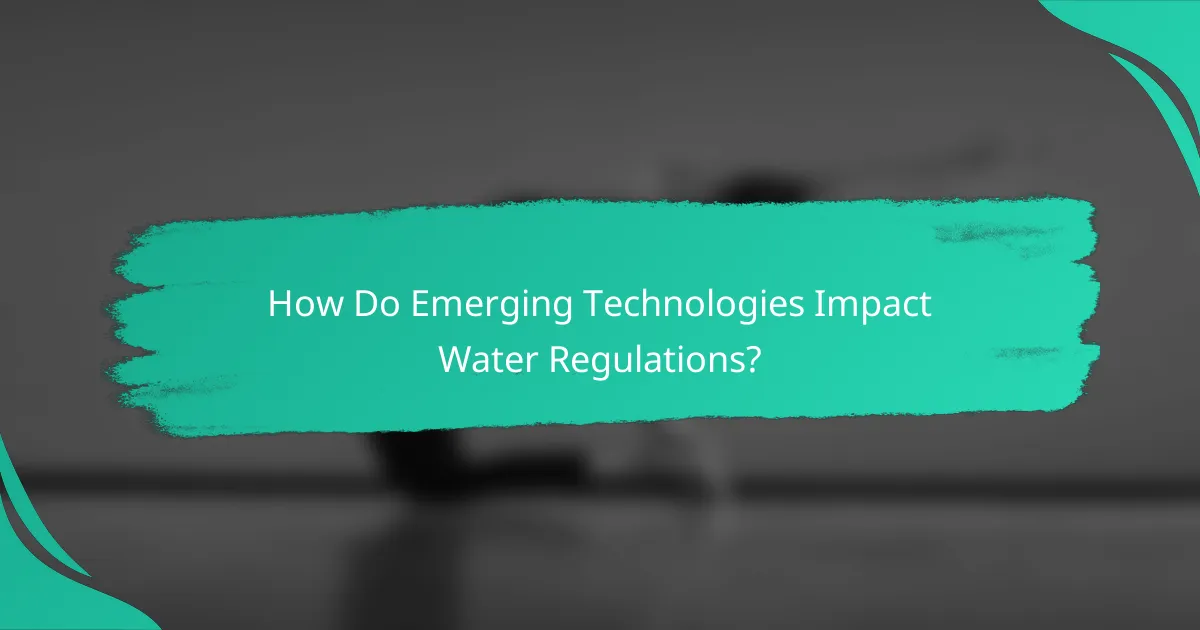
How Do Emerging Technologies Impact Water Regulations?
Emerging technologies significantly influence water regulations by enhancing monitoring, compliance, and management practices. Innovations like artificial intelligence and blockchain are transforming how water resources are tracked, allocated, and conserved, leading to more efficient and sustainable practices.
Artificial Intelligence in Water Management
Artificial intelligence (AI) is revolutionizing water management by enabling real-time data analysis and predictive modeling. AI systems can process vast amounts of data from sensors and satellite imagery to optimize water usage, detect leaks, and forecast demand, which helps in adhering to regulatory standards.
For instance, AI can analyze historical water usage patterns to predict future needs, allowing municipalities to allocate resources more effectively. This proactive approach can lead to significant cost savings and improved compliance with environmental regulations.
Blockchain for Water Rights Tracking
Blockchain technology offers a transparent and secure method for tracking water rights and usage. By creating a decentralized ledger, stakeholders can access real-time data on water allocations, ensuring that all transactions are recorded and verifiable, which enhances compliance with local regulations.
For example, in regions where water scarcity is a concern, blockchain can help manage water rights by providing clear records of ownership and usage. This transparency can reduce disputes and promote fair distribution, aligning with sustainability goals and regulatory frameworks.
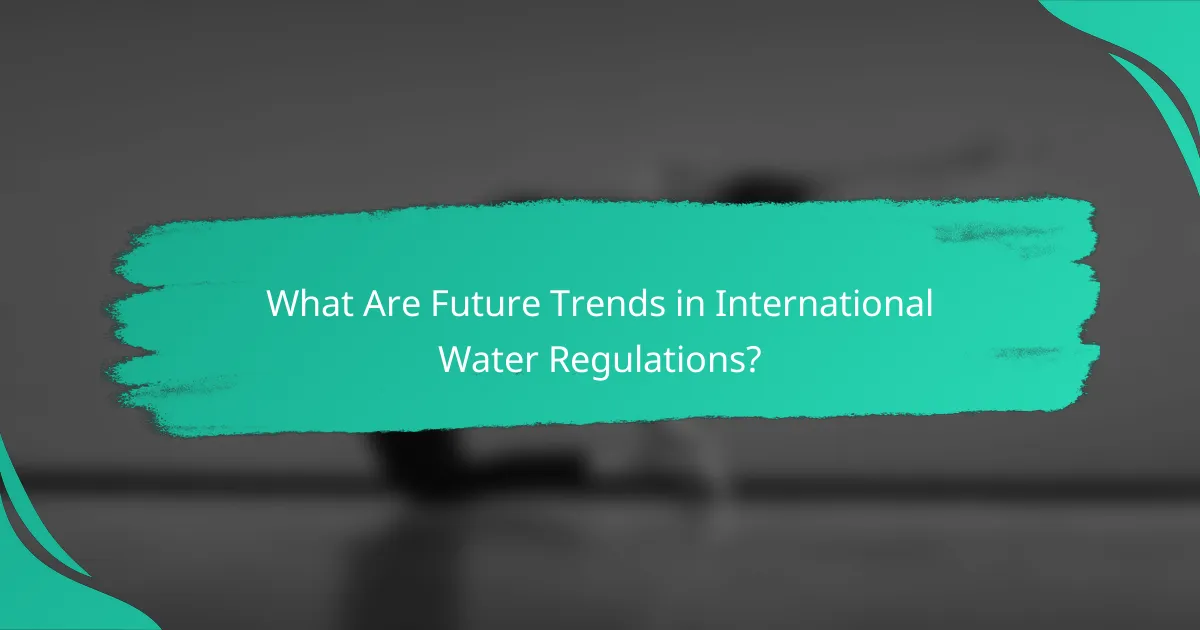
What Are Future Trends in International Water Regulations?
Future trends in international water regulations will increasingly emphasize sustainability and climate resilience. As global water challenges grow, regulations will adapt to ensure compliance with environmental standards while promoting responsible water management practices.
Increased Focus on Climate Resilience
International water regulations are shifting towards enhancing climate resilience, which involves adapting water management practices to withstand climate-related impacts. This focus aims to protect water resources from extreme weather events, such as floods and droughts, which are becoming more frequent due to climate change.
Countries are encouraged to implement strategies that improve the resilience of their water infrastructure. For instance, investing in green infrastructure, such as wetlands and permeable surfaces, can help absorb excess rainwater and reduce flooding risks. Additionally, regulations may require regular assessments of water systems to identify vulnerabilities and implement necessary upgrades.
Stakeholders should prioritize collaboration among governments, NGOs, and local communities to develop comprehensive water management plans. This collaborative approach can lead to shared resources and knowledge, ultimately enhancing the effectiveness of climate resilience initiatives. Common pitfalls include neglecting local conditions and failing to engage all relevant parties in the planning process.
